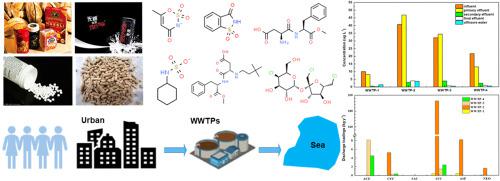Journal of Hazardous Materials ( IF 12.2 ) Pub Date : 2021-02-23 , DOI: 10.1016/j.jhazmat.2021.125498 Wei Guo , Jun Li , Qingwei Liu , Jianghong Shi , Yue Gao

|
Artificial sweeteners (ASs), as a new emerging pollutant, the fate from wastewater treatment plants (WWTPs) to sea is growing concerned. In this study, the distribution and polluted loading of six typical ASs were analyzed based on the measurement in influent, primary effluent, secondary effluent, tertiary effluent, suspended particulate matter (SPM), and sludge from four WWTPs and receiving waters near the coast of Shenzhen city, China. Elevated levels of ASs were detected in WWTPs located near a highly populated area (about 14,000 people km-2). Sucralose was predominant in all water samples (0.1–22.2 μg L-1), and had a 1.6–704.0 times higher concentration than the means of other ASs detected. Aspartame were mainly distributed in SPM and sludge, and the fractions in offshore water exceeded 45%. Acesulfame, sucralose, cyclamate and saccharin could be effectively removed by secondary biochemical treatment. The average daily loading (4.2 g d-1 1000people-1) and discharge loading (0.4 g d-1 1000people-1) of sucralose in WWTPs was higher than those of the other ASs. Dissolved organic carbon and UV254 can affect the fate of ASs, and SPM mainly affects the distributions of aspartame and neotame. As a potential sewage indicator, neotame deserves further attention.











































 京公网安备 11010802027423号
京公网安备 11010802027423号